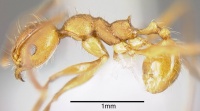Pheidole gulo
| Pheidole gulo | |
|---|---|

| |
| Scientific classification | |
| Kingdom: | Animalia |
| Phylum: | Arthropoda |
| Class: | Insecta |
| Order: | Hymenoptera |
| Family: | Formicidae |
| Subfamily: | Myrmicinae |
| Tribe: | Attini |
| Genus: | Pheidole |
| Species: | P. gulo |
| Binomial name | |
| Pheidole gulo Wilson, 2003 | |
Nothing is known about the biology of gulo.
Identification
See the description in the nomenclature section.
Longino (2019) - In most populations of P. gulo, the minor worker has a fully foveolate face and mesosoma. Specimens from Los Tuxtlas Biological Station in Veracruz, Mexico, and from the slopes of Volcán Atitlán in Guatemala have the face and parts of the pronotum smooth and shining. There is no known site of sympatry of the two forms. The morphospecies code JTL197 was used for the shiny form of P. gulo. In Economo et al. (2019) a shiny specimen from Volcán Atitlán is genetically close to a foveolate specimen from Nicaragua. Pending further evidence, I treat this as one species with geographic variation.
Keys including this Species
Distribution
Only known from the type locality.
Latitudinal Distribution Pattern
Latitudinal Range: 17.5155524° to 10.3085492°.
| North Temperate |
North Subtropical |
Tropical | South Subtropical |
South Temperate |
- Source: AntMaps
Distribution based on Regional Taxon Lists
Neotropical Region: Belize, Costa Rica, Guatemala, Honduras, Mexico, Nicaragua (type locality).
Distribution based on AntMaps
Distribution based on AntWeb specimens
Check data from AntWeb
Countries Occupied
| Number of countries occupied by this species based on AntWiki Regional Taxon Lists. In general, fewer countries occupied indicates a narrower range, while more countries indicates a more widespread species. |

|
Estimated Abundance
| Relative abundance based on number of AntMaps records per species (this species within the purple bar). Fewer records (to the left) indicates a less abundant/encountered species while more records (to the right) indicates more abundant/encountered species. |

|
Biology
Castes
Nomenclature
The following information is derived from Barry Bolton's Online Catalogue of the Ants of the World.
- gulo. Pheidole gulo Wilson, 2003: 295, figs. (s.w.) NICARAGUA.
Unless otherwise noted the text for the remainder of this section is reported from the publication that includes the original description.
Description
A member of the fallax group somewhat similar to Pheidole cockerelli and Pheidole perpilosa (see also the less similar species listed with them), but easily distinguished as follows.
Major: yellow; almost entire dorsal and lateral surfaces of head rugoreticulate, including frontal lobes, as illustrated; almost all of mesosoma and waist foveolate and opaque; pronotal dorsum in addition rugoreticulate; dorsa of petiolar and postpetiolar nodes in addition faintly carinulate; anterior fringe of central strip of first gastral tergite shagreened; pronotal profile in dorsal-oblique view bilobous; postpetiole from above diamond-shaped.
Minor: yellow; dorsal surface of head, mesosoma, and waist foveolate and opaque; anterior strip of pronotal dorsum rugulose; occiput narrowed but at most with a very thin nuchal collar; mesonotal convexity very prominent.
MEASUREMENTS (mm) Holotype major: HW 1.46, HL 1.52, SL 1.00, EL 0.22, PW 0.76.
Paratype minor: HW 0.62, HL 0.74, SL 1.00, EL 0.16, PW 0.44.
COLOR Major: body medium reddish yellow (“orange”), appendages light reddish yellow.
Figure. Upper: holotype, major. Lower: paratype, minor. Scale bars = 1 mm.
Type Material
NICARAGUA: Rio Kukra, col. Ivette Perfecto. Museum of Comparative Zoology
Etymology
L gulo, glutton, wolverine.
References
- Wilson, E. O. 2003. Pheidole in the New World: A dominant, hyperdiverse ant genus. Harvard University Press, Cambridge, MA. (page 295, fig. major, minor described)
References based on Global Ant Biodiversity Informatics
- Dattilo W. et al. 2019. MEXICO ANTS: incidence and abundance along the Nearctic-Neotropical interface. Ecology https://doi.org/10.1002/ecy.2944
- Longino J. T. 2019. Pheidole (Hymenoptera, Formicidae) of Middle American wet forest. Zootaxa 4599: 1-126
- Longino J. T. L., and M. G. Branstetter. 2018. The truncated bell: an enigmatic but pervasive elevational diversity pattern in Middle American ants. Ecography 41: 1-12.
- Ottonetti L., L. Tucci, F. Frizzi, G. Chelazzi, and G. Santini. 2010. Changes in ground-foraging ant assemblages along a disturbance gradient in a tropical agricultural landscape. Ethology Ecology & Evolution 22: 7386.
- Wilson, E.O. 2003. Pheidole in the New World: A Dominant, Hyperdiverse Genus. Harvard University Press

